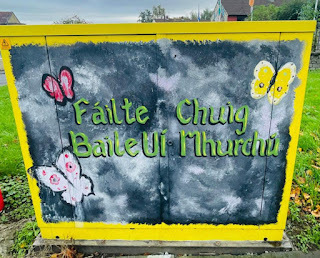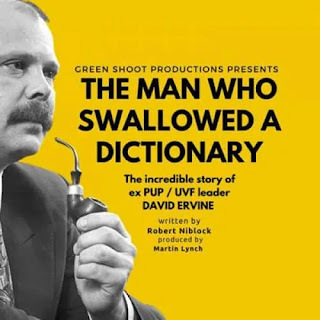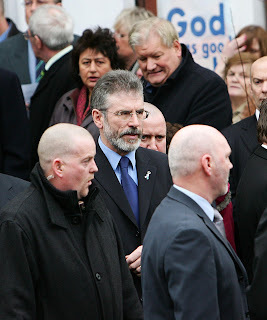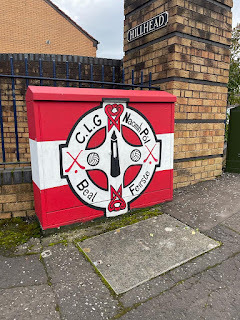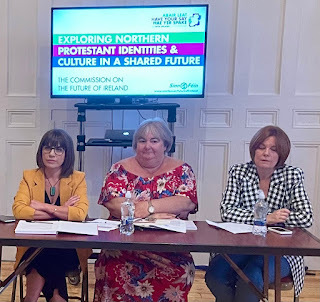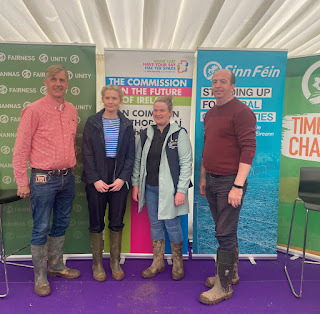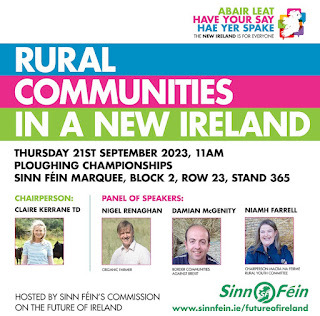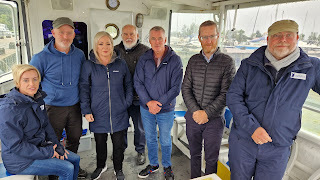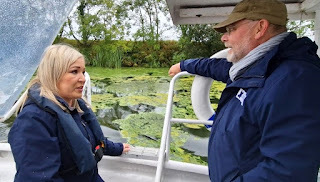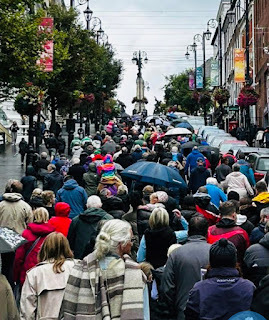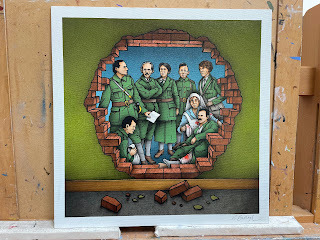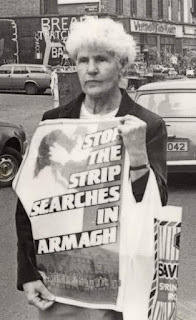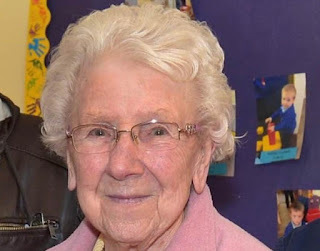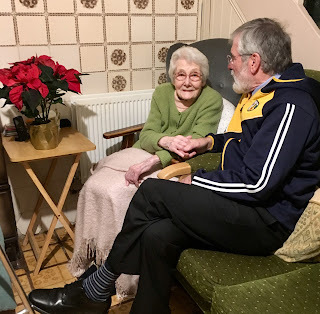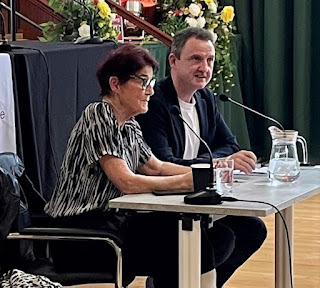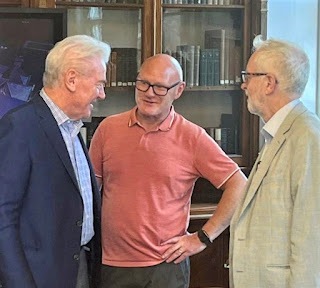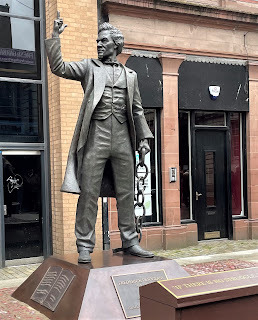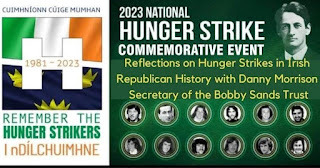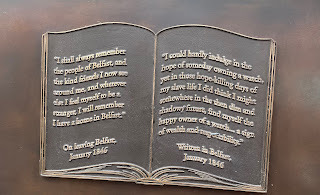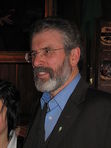Gerry Adams's Blog, page 10
October 16, 2023
Peace Talks Now: On Being Seventy Five: More Street Art.
 At the separation wall around Bethlehem 2009
At the separation wall around Bethlehem 2009 Peace Talks Now
The scale of the assault byPalestinian fighters into Israel last weekend is unparalleled. The scenes ofdeath and destruction on both sides are heart breaking. But shock and despairat more violence in that region is not the answer.
The roots of these events areto be found in the failure of the international community to take decisivesteps to defend international law, challenge Israeli aggression and itscontinued illegal occupation of Palestinian land, and to recognise the rightsof the Palestinian people.
Over the last year there havebeen increased killings of Palestinians, particularly children, by the IsraeliDefence Forces and by Israeli settlers. At the same time the theft ofPalestinian land, the existence of the Separation Wall, the growth in Israelisettlements and the destruction of Palestinian schools, homes, sources of waterand the imprisonment of thousands of prisoners, have largely been ignored bythe international community.
History teaches us that whencolonisers engage in wholesale military, political and economic repression andignore the democratic rights of citizens, this is likely to lead to conflict.This is not new. It is story of colonialism in countless states across theworld, including here in Ireland.
I warned of this potential inApril 2009 following a visit to the region. During my time in the west Bank, inJerusalem and the Gaza Strip I met a huge number of NGOs, Israeli andPalestinian human rights organisations, women’s groups, communityorganisations, a member of Kadima, and all of the main Palestinian politicalparties.
In a subsequent report of thevisit I wrote that decades “after the emergence of the Israeli state and thepartition of Palestine, and with the increasing sophistication of the weaponsof war on all sides, it is clear that no wall – however high – can providepermanent peace or security.”
I added: “Refusing to engage indialogue; demonising opponents; treating them as non-citizens; stripping themof their rights and entitlements, of their self esteem and integrity as humanbeings; engaging in censorship and vilification, makes war easier and peaceharder. It is a policy which guarantees a perpetuation of the cycle ofconflict.”
The alternative then and todayis obvious. Dialogue. Negotiations. More dialogue.
So, after the weekend’s eventwhat should happen next? In 2009 I proposed that:
· All armed actions or threats ofarmed actions should cease immediately.
· An inclusive process ofnegotiations should commence in which all democratic mandates are respected,clear objectives are set, and there is a fixed timeframe.
· The siege of the Gaza Stripshould end.
· An immediate and intensiveprogramme of reconstruction and economic development must commence.
· The ongoing Israelicolonisation of the West Bank and the building of settlements should stop.
· The occupation of the West Bankand the denial of freedom of movement to Palestinians in the West Bank and inthe Gaza Strip, and between the west Bank and Gaza, should end as part of theprocess to decolonise the West Bank.
· Mutual and expeditiousco-operation between Palestinians and Israelis to enhance public safety andsecurity should commence.
· United Nations Resolutions andInternational Law should be enforced.
These steps are even morenecessary today. 75 years after the state of Israel was established andmillions of Palestinians were forced from their homes to become refugees theimperative of achieving a political settlement is more urgent that ever.
However difficult it will bethis is the time for dialogue. The demand of the international community mustbe for an end to all violence. All those who are decrying lastweekends terrible events in the MiddleEast should organise ainternational intervention to establish a proper negotiations process, basedupon international law. Anythingelse is unacceptable. The Irish government could and should play a leadershiprole in such an initiative. Dialogue,dialogue is what is required. As soon as possible. Thatmeans NOW!
Thealternative is too terrible to contemplate.
On Being Seventy Five.
I published a version of thisreflection when I was seventy two.Following my recent 75th birthdayI think it deserves another slightly revised outing. I might rewriteand republish it again when I ’ meighty. Who knows?
Icelebrated my seventy fifth birthdaylast week.
Seventy five is closer to eighty
Than itis to sixty. Or fifty. Or forty. Or thirty. Or twenty.
But Iknow that
I willnever be sixty. Or fifty. Or forty. Or thirty. Or twenty.
Everagain.
Sin é.
That’sthe way of it.
That’slife.
Butwill I ever be eighty? Nobody knows. That’s the mystery of it.
Thewonder of it. The adventure of it. And the hope.
Me?
I hopeto know my grandchildren’s grandchildren.
But nottoo soon a thaiscí
That’simpossible say the naysayers.
Nothingis impossible I reply.
Contentthat
We willfind out in the end.
Well,some of us will.
Untilthen I will try to live every day
Like itis my last day.
Andeventually I will be right.
Butfrom now until then
I amsure
Thebest is yet to come.
Gort Na Mona are leading theway in the Upper Springfield with their brightly coloured electric boxes.
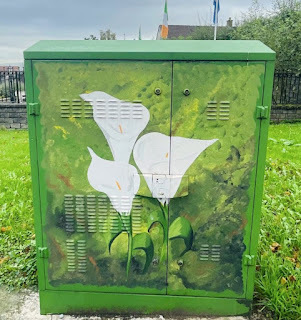
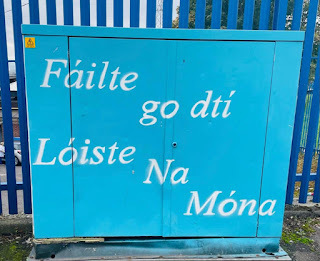
October 10, 2023
David Ervine - The Man Who Swallowed A Dictionary: Street Art: Mól An Óige.
David Ervine - The Man Who SwallowedA Dictionary
Anyone who knew David Ervine or knowsof him will appreciate the title of Bobby Niblock’s play - The Man WhoSwallowed A Dictionary. In its humorous description of David’s style ofspeaking and wordiness it reminds us of a political leader who was an able anddetermined advocate for working class loyalism. His sudden death in January2007 at the age of 53 left a political vacuum within loyalism and widerpolitics which has never been properly filled.The Progressive Unionist Party which David led has failed to garner the popularpolitical support that it was once thought capable of under hisleadership.
I have not yet had an opportunity tosee Bobby’s play but friends whohave thoroughly enjoyed the one-man show.They praised the script and actor Paul Garrett who successfullybrings the nuances and David’s voice to life on the stage with just twolarge books, a bushy moustache and a pipe as his props.
During the course of the negotiationsleading to the Good Friday Agreement and in the years afterward I met Davidmany times. Among otherthings we were both pipe smokers. He was also articulate, genuine, and deeply committed to his brand ofunionism. He had a goodsense of humour. He was very socialable. In Kerry in support of the projectinvolving young people from East Belfast to build a replica ofThe Jeanne Johnson - a ship used during the Great Hunger to transport starving Irishto America - David and Martin Ferris would often adjourn to alocal pub to scull pints and chat about sport.
But healso had no illusions about thechallenges facing all of us as we worked to chart a course from conflict topeace. While the Ulster Unionist leaders refused to talk to Sinn Féinthroughout the negotiations leading to the Good Friday Agreement David and his colleagues played no such games.
An east Belfast working-classProtestant David Ervine was drawn into the loyalism at an early age. In 1972 hejoined the UVF and two years later he was imprisoned in Long Kesh forpossession of a bomb. David spent five and a half years there. When he wasreleased he was more politically and socially conscious. He wasself-assured, confident and argued for greater positivity and dialogue withinunionism. In the discussions that were taking place in the 1990s about movingfrom conflict into some sort of peace and political process David’s voice, alongwith Billy Hutchinson and others, became increasingly important andinfluential within the protestant/unionist/loyalist (PUL) community.
He often criticised unionistpolitical leaders for using loyalist paramilitaries, and the threat of loyalistviolence, as leverage in their confrontations with the British and Irishgovernments, and who then discarded them when they no longer mattered. “Ifanybody in Northern Ireland thinks that the Protestant working class communityhas benefited from the mechanisms that they [the DUP] advocate, then there issomething wrong with their heads.” Two decades later and this dangerousgame is still being played although it has to be said many loyalistgroups go along with this despite being conscious of being used by unionistparties.
On another occasion talking aboutsectarianism he said: "Many people come from places where drawing-roomsectarianism is at its worst … and they have luxuriated and benefited associety, divided more and more, crashes on the rocks." It is a greatpity that today’s loyalists don’t see the folly of this. They continue to allowthemselves to be used.
In an interview with Danny Morrisonin 2002 David acknowledged that the conflict had its origins in the North’sone-party unionist state and the discrimination levelled against Catholics. Ata time when the issue of Irish Unity wasn’t attracting the interest it is todayDavid said that he would “accept a united Ireland if a majority in the Northvotes for it.” His preference of course was to make the North work foreveryone. His thoughts on what motivates unionism are probably more relevanttoday than they were 20 years ago when the current momentum toward Irish Unitywas not so strong.
He told Danny: “You’ve got tounderstand how unionism works. There is a huge insecurity within unionism.Unionism really hasn’t had time to settle. They feel that the republicanagitation is never going to stop. The one thing that unionists lust for isstability. It’s the one thing they have never had.”
At David's Funeral
Later he said: “I am what I am. I amboth Irish and British but I’m a democrat too… There’s nothing more fascistthan someone telling you what you are, especially if you perceive yourself tobe somewhat different… We are steeped in concepts of Britishness… but those whoare the legal arbiters are the people of Northern Ireland. It is absolutelylegitimate for republicans to argue the validity of a united Ireland but thenew dispensation is worthy and there should be no Plan B. My mother and fatherwere Irish, my grandparents, and very simplistically so. But there are argumentsabout the haunting mist of the 1937 Constitution that forced the unionistpeople to re-think their Irishness.”
If he were still with us we couldhave a good debate over some of this. But nonetheless today we increasingly seeprotestant/unionist voices embracing the notion of being Irish and of equalityand parity within the context of constitutional change. If David were here nowhe would be in the middle of this conversation, smoking his pipe andadvocating his views.
His sudden death in January 2007 was ashock. Alex Maskey and I attended his funeral in East Belfast. It was anopportunity to let his wife Jeanette know how much David was respected and ofour sincere gratitude for the immense contribution he made to the peace processand to the Good Friday Agreement.
Street Art.
When I had the honour to represent the fine citizens of Louth and East MeathRichard and I spent a lot of time in Dublin. In between marathon shifts inTeach Laighean we used to walk the streets of the capital. Both of us were taken by theinitiatives to paint utility fittings like electric boxes with images of localor national figures, pithy slogans, landscapes, iconic landmarks and abstract designs.
Drab grey metal was transformed intobright eye catching and mind lifting street art. Now I see this is beingreplicated in Belfast. Naomh Pól and Rossa are leading the way. Very well done.Let’s see other clubs doing their thing. And images also of local people orflora and fauna or relics of the linen industry or butterflies, locallandmarks and local art.
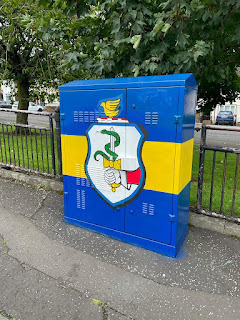
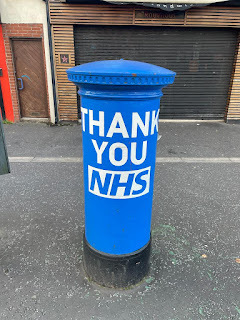
Mól An Óige.
If you are in Belfast between nowand November 9 call into the Gerard Dillon Gallery in AnCultúrlan McAdam Ó Fiaich on the Falls Road and marvel at the brilliance of theyoung students of Coláiste Feirste. Fair play to them all and to theirteachers. The future is bright. They are a valued and wonderful part of thearts and wider community. A credit to themselves, their families, to Belfastand Ireland. Mol an óige agus tiocfaidh sí
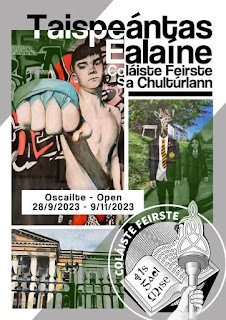
October 2, 2023
We must listen to each other: My Big Toe: Tom Dunn - the Peasant Patriot
Catherine Pollock, Catherine Cooke and Alison Wallace in Derry
We must listen to each other
Efforts by the Britishgovernment and the unionist parties to stymie the conversation on futureconstitutional change has actually brought a greater focus on the growingmomentum around the upcoming unity referendum. The criticism of AnTaoiseach Leo Varadkar by the British Secretary of State and a range ofunionist voices for daring to suggest that a United Ireland will happen in hislifetime is the latest example of unionist and Tory efforts to delegitimise thegoal of Irish Unity.
In their view it is not acceptableto promote Irish Unity. This is presented by them as dangerous anddestabilising and is criticised and condemned with contempt. Theintention is to create a row so that United Irelanders will be quiet and to misrepresentrepublican and nationalist aspirations as second class. Nonsense, blusterand feigned outrage will not stop the conversation about the future. Listeningand learning makes more sense.
Twenty five years ago theGood Friday Agreement acknowledged the “equally legitimate,political aspirations” of nationalists and unionists. The talks participants,including the Irish and British governments, and subsequently the majority ofcitizens in a referendum, accepted that the future had to be one based onpartnership, equality and mutual respect. The Agreement recognised thebirthright of all the people of the North to identify themselves and to beaccepted as Irish or British. A referendum process was agreed to determine thefuture constitutional shape of the island of Ireland
The DUP and the Tory government do not accept theseprinciples. That much is clear. They want to delay and dilute the changes thatare coming. But in their hearts they know they cannot stop them. That much isclear also. The unity genie is out off the bottle. It is not going inagain.
In recent weeks Sinn Féin’s Commission on theFuture of Ireland has held two very successful public events. One was at thePloughing Championship last week in Laois.
This put a focus on the benefitsthat Irish unity will bring to rural Ireland. The other event was held in Derrywhere three women from the unionist section of our community participated in anevent billed as: “Exploring Northern Protestant Identities and Culture in aShared Future.” The three participants – all community based activists -Catherine Pollock, Catherine Cooke and Alison Wallace are from that broadtradition.
The event was very informative and the three womenspoke eloquently of the concerns and of the diversity of opinions andtraditions that exist within unionism. Speaking afterward Chairperson of theevent, Catherine Pollock said that she hoped those who attended would begin tounderstand the “diversity of feeling, traditions and culture among the unionistcommunities.” The conversation ranged across how people can engage and moveforward in civic and political conversations, on the environment, a citizensAssembly on education, the marching bands and much more. Catherine Cooke hopedthat what they said would provide food for thought: “I came in feeling verynervous but leave feeling very good.” Alison Wallace said: “People listened and
were very respectful.” She described it as a very positive experience.We need more of these events, of theseconversations. Irish republicans and nationalists must listen carefully andattentively to what our Protestant/Unionists neighbours are saying in all oftheir diversity. And we need to plan for the future.
Thus far the Sinn Féin Commission has held eightpublic events, as well as sectoral engagements. Two more will be held by theCommission in the coming months. There will be a Peoples’ Assembly in Waterfordon 12 October and another through Irish in the Galway Gaeltacht in November.
Incidentally during a recent visit to New York An Taoiseach Leo Varadkarmet US President Joe Biden. He said Mr Biden was very well informed on Irishaffairs and that he asked if there was any way he could help. Mr Varadkar says:“I told him we had no specific ask at the moment …”
It’s little wonder the British governmentdisrespects the Irish government the way it does. An Taoiseach needs to listenand learn also. And to work with those who are prepared to help. In Ireland.And internationally.
My Big Toe
Jim Donnelly is a Springhallion.His mother, May Donnelly, was one of the indomitable warrior women from the Upper Springfield who faced down hordes ofBritish soldiers and RUC officers for decades while also combatting poverty anddiscrimination and rearing a good family. These mighty women are to be found incommunities everywhere. The local ones are too many to name but I remember themall and I am grateful for their friendship and protection and comradeship. AndI am always uplifted by the tenacity and good humour of these working classheroines, mostly mothers of large families, including Mrs Donnelly.
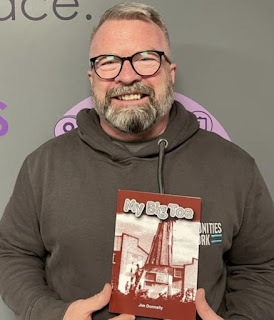 Little wonder then that shehas a central role in Jim Donnelly’s book - My Big Toe. Jim is a communityactivist from Springhill. Like many of his neighbours he is also a formerprisoner -he did nine years hard time. His life as a communityactivist is dedicated, again like many others, to tacklinginequalities and developing a better society for all with a particular focus onyoung people especially through his role as joint CEO with the Active CommunitiesNetwork.
Little wonder then that shehas a central role in Jim Donnelly’s book - My Big Toe. Jim is a communityactivist from Springhill. Like many of his neighbours he is also a formerprisoner -he did nine years hard time. His life as a communityactivist is dedicated, again like many others, to tacklinginequalities and developing a better society for all with a particular focus onyoung people especially through his role as joint CEO with the Active CommunitiesNetwork.
Jim’s journey through writing wasa difficult one. At school he was dismissed as ‘slow at everything hedoes.’ He says he became like a ghost in the classroom. ‘I was therebut no one really noticed’.
In prison he read a lot. Withgreat difficulty. Ditto with his writing. It was a struggle. After his releasefrom prison he endured anxiety, depression and mental health issues. He thenwent on to do a Higher Professional Diploma in Counselling. As part of thiscourse he had to keep a journal. This enabled him to explore his life and hisexperiences. Later he studied for a Masters Degree. Again more reading andwriting. More challenges.
Jim almost abondoned this workbecause it was too hard for him but his tutor got him to talk to an educationalpsychologist. She told him he was dyslexic. He understood then why he had such a hard time with reading andwriting, why school work was so difficult. This gave him the impetus tocomplete his masters degree - a great accomplishment for a disadvantagedlad from Springhill. Jim is one of the many men and women whosucceeded against the odds. In all kinds of ways. In all sectors. And ourchildren or grandchildren have done even better.
Jim’s book - poems andprose- came to be published through the efforts of his friendsespecially Danny Barkley. When Jim began writing on his phone he shared hismusings on WhatsAppwith Danny, Harry Connolly, Conor , Louise and other friends and family. Dannythought Jim’swork should be published. He talked to Harry about this but didn’t tell Jim, probably as Jim acknowledgesbecause “Iwouldn’thave been convinced”. MyBig Toe was published as a gift to Jim by his friends.
So well done Danny andcompany.
My BigToe is brutally honest reflection on life growing up under militaryoccupation, in a large poor working class family in a republican community inthe time of conflict. It is frank about the traumas, hardships and indignities.The ups and downs. But it is also funny and full of love. My Big Toe is a taleof redemption. When I asked Jim how people can get a copy he laughedand said “Sendthem to Danny Barkley”.
My Big Toeis available in limited numbers from the author at ActiveCommunities Network, Twin Spires, Falls Road.
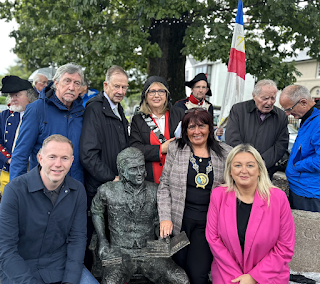 Tom Dunn – the Peasant Patriot
Tom Dunn – the Peasant Patriot
Well done to the people ofRostrevor who last week invited former President Mary McAleese to unveil abronze statue to Tom Dunn – the Peasant Patriot - a local hedge school masterand United Irish leader who taught ‘The Rights of Man’ by Tom Paine and thewritings of Wolfe Tone to local patriots. In 1797 Tom’s barn was raided by theBritish and he was captured. He refused to name any of his comrades. He wasordered to be lashed. He died, aged 62, after 260 lashes. Think about that dearreaders. 260 lashes.
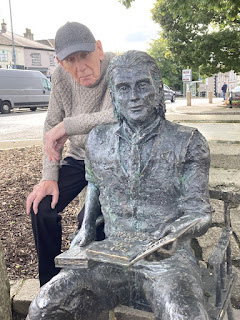
September 27, 2023
Lough Neagh facing an ecological disaster: Tory backing for Pinochet: Siúlóid An Taoisigh.
Mid Ulster MP Francie Molloy at Lough Neagh
Lough Neagh facing an ecological disaster
Upthe Shore
i
The lough will claim avictim every year.
It has virtue thathardens wood to stone.
There is a town sunkbeneath its water.
It is the scar left bythe Isle of Man.
ii
At Toomebridge whereit sluices towards the sea
They’ve set new gatesand tanks against the flow.
From time to time theybreak the eels’ journey
And lift five hundredstones in one go.
iii
But up the shore inAntrim and Tyrone
There is a sense offair play in the game.
The fishermen confrontthem one by one
And sail miles out andnever learn to swim.
Iv
‘We’ll be the quickergoing down,’ they say.
And when you arguethere are no storms here,
That one hourfloating’s sure to land them safely –
‘The lough will claima victim every year.’
Seamus Heaney’s poem, published in 1969, capturesmuch of what makes Lough Neagh unique. It has long been a place of myth and fable,where the palace of the Tuatha Dé Danann is supposed to lie beneath its waves.It is said that Lough Neagh was created by the giant Finn McCool who legendclaims scooped out a huge chunk of earth and threw it after the Scottish giantBenandonner. He missed and thus created the Isle of Man. Richard believes thatthe Lough was created 400 million years ago as a result ofmassive tectonic events.
People have lived and worked around the shoresof Lough Neagh for thousands of years. This is evident in thehuge number of artefacts and ruins. Stone axes have been foundat Toome and Shanes Castle. Neolithic pottery has also beenfound at Newferry north of Toome.
In the ninth century the Lough was a base for aViking fleet as part of their efforts to occupy Ireland.
Following the English invasion of Ireland theshores of Lough Neagh have witnessed many battles. It played a strategicallyimportant role in the English defeat of the O’Neill and O’Donnell clans in thelate 16th century and in the subsequent plantation of Ulster.
The Lough is the largest fresh water lake inIreland. It is home to many rare plants, waterfowl and fish. It is bordered byfive counties – Antrim, Down, Armagh, Tyrone and Derry. For millennia it hasbeen at the heart of the local economy. A transport hub before roads and amajor source of fishing that has provided a living for the generations who havelived around its’ almost 400 square kilometres. It is a significant culturaland historic site and in more recent years a place for water sports andrelaxation for tens of thousands. It also provides 40% of the fresh water forcitizens living in the North.
Today all of that is under threat. Recent satelliteimages have shown the extent to which a toxic blue green algae has infested theLough. Cyanobacteria is a danger to animals and humans. According to the LoughNeagh Partnership climate change and the increased water temperature of theLough has created the conditions for this algae to thrive.
In addition millions of tons of sand have beendredged from the floor of the Lough for building projects here and in Britain.In an article by Tommy Green in The Detail last December he reported thataround 30% of the North’s “construction sand comes from Lough Neagh … Priorto 2021, when extraction was unregulated, it is estimated that at least 1.1m-1.8m tonnes were being dredged from the Lough every year…”
Sinn Féin team meet Lough Neagh Partnership
The Lough Neagh Fishermen’s Co-operative Societywarned last year that sand extraction was destroying habitat areas on the floorof the Lough and that this was reducing the number of fish. Theimpact of the climate crisis, the presence of a toxic algae, the incidence ofraw sewage and the dredging of the Lough floor and the destruction of thatcritical underwater environment, mean that Lough Neagh is now facing anecological disaster.
With 40% of the North’s population relying on LoughNeagh for fresh, clean water there is mounting concern that none of thegovernment departments are prepared for or appear willing to take the stepsnecessary to protect this hugely important community and environmental asset.
Last week First Minister designate MichelleO’Neill, Francie Molloy MP, Declan Kearney MLA and Philip McGuigan MLA met withthe Lough Neagh Partnership. Later Declan Kearney led a political andcommunity delegation, including Philip McGuigan, locally based councillors,fishermen, anglers and the Lough Neagh Partnership, to meet seniorofficials of the NI Environment Agency and Inland Fisheries.
The message is clear. As Mid Ulster MP FrancieMolloy said: “The situation is untenable. The Lough needs to be brought intopublic ownership and managed by a community partnership.” Thismust include the bed of the Lough which is currently owned by an absenteeBritish Earl who receives royalty payments for every tonne of sands extractedfrom the bed of the Lough.
There is also an urgent need for a comprehensiveand co-ordinated action plan to tackle the toxic algae. A multi-agency andinter-departmental task force is a priority. Public ownership will facilitate aclear management structure to provide immediate and long-term plans to keep theLough safe and sustainable for future generations.
When I was a young lad a gang of us from Ballymurphy led by Joe Mageeused to walk to Lough Neagh and spend the day there. Decades later in Long Keshsome of us used to feast on Lough Neagh eels sent to us by the bucket full. Thestory of Lough Neagh is an integral part of the story and history andenvironment of the island of Ireland. The ecological crisis it currently facesarises from the actions of human beings. It is our responsibility to changethat.
Michelle O'Neill with the Gerry Darby of the Lough Neagh Partnership
Tory backing for Pinochet
Many of my generation will remember the militarycoup in Chile in September 1973 that overthrew the socialist President of ChileSalvador Allende. The images of the bombing of the Presidential Palace, of anarmed and courageous Allende defending the building and the quickly emergingreports of brutality by the Chilean military, horrified many around the world.
The coup was led by General Augusto Pinochet incollusion with the CIA. In the years that followed Chile became a byword insummary executions, torture and repression. Almost 20 years later when theregime fell a truth commission revealed that 40,000 people had been tortured,200,000 had been forced to flee the country and at least 3,000 werekilled.
The British government led Edward Heath stronglysupported the junta. Foreign Secretary Alec Douglas Home wrote that: “ForBritish interests … there is no doubt that Chile under the junta is a betterprospect … and the sky-high price of copper (important to us) should fall asChilean production is restored.” One third of Britain’s copper importscame from Chile. Allende’s nationalisation of the copper industry in July 1971had been condemned by the USA and Britain.
The Labour government that followed Heath imposedsanctions on Chile but during Margaret Thatcher’s tenure as Prime Minister sherestored diplomatic relations; authorised visits by British Ministers to Chile;and lifted the arms embargo. Hundreds of members of the Chilean armed forceswere trained by the British and in September 1982 the Thatcher governmentrefused to support a motion at the UN condemning Pinochet’s human rightsabuses. British political and economic interest once again trumped human rightsand international law.
In October 1998 Pinochet was arrested in London.Not surprisingly Margaret Thatcher campaigned hard to secure his release. Hewas returned to Chile in March 2000. By their friends we will know them.
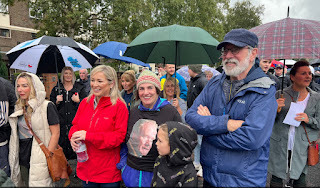
SiúlóidAn Taoisigh.
Thiscolumn had a great day out in Derryat The Chieftain’s Walk organisedby The Martin McGuinness Peace Foundation and Martin’s family led by his wifeBernie. There was a similar event in New York. Well done to all involved. Itwas good to meet many of Martin’s old friends and to walk the ground he trod onmany, many times. Despite the rain there was a great turn out.
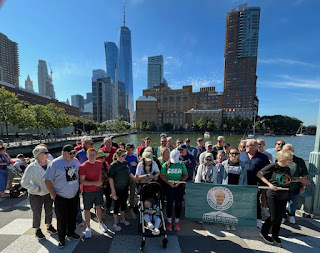
New York
Derry
September 18, 2023
Time to say Yes to Palestinian State: Raising Awareness about Sepsis: Sláinte
Timeto say Yes to Palestinian State
Lastweek the Tánaiste and Minister for Foreign Affairs Micheál Martin visitedIsrael, the West Bank and Jordan. It was an opportunity for the Irishgovernment to take a firm stand against Israeli aggression and its apartheidsystem of governance. Instead Mr. Martin became little more than a commentatoron the ongoing and worsening crisis in that region.
WhileMr. Martin was occasionally critical in his public remarks of the expansion ofIsraeli settlements into Palestinian land and concerned at the daily attacks byIsraeli settlers on Palestinian homes and families there was little ofsubstance to his visit. With Israeli Prime Minister Binyamin Netanyahu makingclear there would be no change in Israeli policy and his government’s veto overany possibility of viable negotiations toward a peace agreement, it needs morethan meaningless rhetoric from An Tánaiste. It needs action from the Irishgovernment to give peace a chance.
[image error]Three months ago membersof the ‘Commission of Inquiry on the Occupied Palestinian Territory,including East Jerusalem’, visited Dublin. The Commission was established bythe United Nations following the 11-day Israeli bombardment of the besiegedGaza Strip in May 2021. Two hundred and fifty Palestinians and 13 Israeli’swere killed in that period. While praising the cross party approach in LeinsterHouse the Commissioners said “at this stage of the situation on the ground,mere statements – no matter how progressive are not sufficient. We need moreaction.”
Therewas no action from Mr. Martin. Rather he chose to urge the Palestinian leaders“to take risks in terms of the pursuit of peace.”
In 2015 the Oireachtas supported a motion callingon the Irish government to recognise the State of Palestine. Itrefuses to do so claiming that such a move must be part of a new peaceagreement. And yet Micheál Martin last week acknowledged that on the basis ofhis conversations with Israeli leaders: “I don’t see any immediate signs of achange in direction.” And why should they when the Irish government and othersstand aside and facilitate Israeli aggression?
If the Irish government is seriousabout peace in the Middle East it should move immediately towardrecognising the State of Palestine and using its membership of the EuropeanUnion and the United Nations and its international influence topersuade others to do likewise. It’s time for action.
RaisingAwareness about Sepsis
Themonth of September has been designated as Sepsis Awareness Month. Sepsis is nota condition that often attracts attention but across the island of Irelandannually there are an estimated twenty two thousand cases of sepsis. Of these,approximately three and half thousand victims die. In the South sepsis killsmore people than breast cancer, prostate cancer and AIDS combined. Sepsis alsois the number one killer in deaths in hospitals in the USA. Every year 350,000people die from it.
Whilethousands of miles apart two Irish families, one in Ireland and the other inthe USA, who have been tragically touched by sepsis, have initiated campaignsto draw attention to this silent killer.
In NewYork in 2012 Rory Staunton, the 12 year old son of Ciaran and Orlaith, diedfour days after taking ill. I knew Rory. He was an articulate, enthusiastic,intelligent and very astute young person. He fell ill after playing basketballin school where he slightly cut his arm in a fall. Overnight he becamefeverish, vomited and developed a pain in his leg. He was taken to hospitalwhere essential warning signs were missed. He eventually ended up in intensivecare but four days after the accident he died of septic shock.
Ciaranand Orlaith established the ‘End Sepsis, the legacy of Rory Staunton’Foundation and have fought tirelessly since then to introduce ‘Rory’sRegulations’ – new rules and protocols - to ensure that medical staff aretrained to recognise the symptoms of sepsis. It is estimated that 20,000 livesin New York State alone have been saved by their efforts.
Lastweek the case of 15 year old Seán Hughes from Dublin was highlighted. He diedfrom sepsis in 2018. His father Joe described his son as a “healthy young man”who was a “singer, entertainer, comedian and best friend to all who had thepleasure of knowing him.” Seán was a well known and popular rapper who hadperformed under the stage name Lil Red in the Aviva Stadium and the NationalConcert Hall.
InJanuary 2018 he came home from school with what appeared to be flu-likesymptoms similar to a chest infection. He was eventually taken to hospitalwhere doctors “were baffled as they had absolutely no clue what was wrong.”Sean died after four days. The family only discovered at the inquest that thecause of death was sepsis, a disease they had never heard of before.
LikeCiaran and Orlaith in New York Seán’s parents, Joe and Karen, decided to raisepublic awareness about sepsis. They have established ‘Lil Red’s Legacy SepsisAwareness Campaign.’ This includes Sean’s parents going to schools, collegesand sports clubs to make their presentation.
Welldone to these two families who have courageously who despite their heartacheare actively involved in trying to help others.
Awarenessis hugely important but so too is training and resources for family doctors andhospitals. If you have concerns information on sepsis is available at https://www.nidirect.gov.uk/conditions/sepsis and https://www.hse.ie/eng/about/who/cspd/ncps/sepsis/
Sláinte
A friend of mine has told me that he is thinking of giving upthe drink. He has been saying the same thing for the last ten years so you willunderstand if I dont take him too seriously. In the past his desire to beabstemious coincided with his hangovers. When the hangover retreatedso did his desire to be teetotal. But this time he seems to be moreserious.
“It’s my age” he told me “I’m not fit to drink the way I usedto. A couple of pints and I’m stupored. And then I have to runto the toilet for the rest of the night, especially in the middle of the night.My bladder does be like a hard hat.”
He looked at me across the table. We were in a pub. He was drinking alcoholfree beer.
“Alcohol free beer misses the wholepoint” I observed. “And it probably has the same porous effect on your bladder.”
“Probably so” he replied. “But the taste is the same and you don’t feel like a tube drinking water ora soft drink in company. There is also a limit on how much water you can drink.”
He gazed forlornly at my pint.
“We Irish drink too much anyway”, he continued.
“No more than any other society” I suggested.
“Maybe so” he conceded “but we drink differently. We drinkto get drunk. Others drink with their food or in a measured way. A few glasses. Not us. We go out for a session. Toget plastered. I can’t hack getting stocious any more.”
“Fair enough” I agreed with him. “So drink less. You don’t need to get legless.”
“I rarely get legless” he responded.
“I’m well able to hold my drink. Youknow that. But having just one or two drinks on a night out? That’s easier said than done.” He said sadly.
“First you get the bottle. Then thebottle gets you.”
“So how long are you off the drink” I asked.
“Since last night.”
“I wish you well” I replied, resisting the temptation to ridicule him.
“I will let you know how I get on”, he smileddeterminedly.
“Are you off buying drink as well” I queried. “Mines a pint and it’s your round.”
“Maith go leor” he said.
“By the way a wee bit of advice for you” I continued.
“Don’t broadcast it that you are off thedrink. Too many of our friends take pleasure when people go on thewagon and then fall off it again. Just say you’re not drinking that night.You’re driving. Or you’re minding the grand kids. Or you have something to doearly in the morning.”
“Good advice” he said. “Dont you tell anyone.”
“Ok” I replied. “My lips are sealed.”
September 11, 2023
Unique Robert Ballagh Moore Street Print; You Are Never Alone With A Book: Walking with my Mother
Unique RobertBallagh Moore Street Print
As regular readers ofthis column know I have been involved for a very long time in the campaign toprotect and develop as a historic and cultural quarter the Moore St. Terraceand its environs in Dublin. The entire terrace 10-25 Moore Street was occupiedby the evacuated GPO garrison at the end of Easter Week 1916. The developer -Hammerson - wants to demolish much of the terrace.
The Moore St.Preservation Trust, with the support of relatives of the 1916 leaders, isworking with a legal team to prepare a legal challenge should An Bord Pleanáladecide to grant Hammerson permission to knock down any part of this historicterrace. All of this will involve significant costs. As part of the Trust’scampaign to raise awareness, and to raise funding for any legal challenge, theMoore Street Preservation Trust will tonight be launching a new image ofthe last meeting of the Provisional Government following the Easter Rising in1916 by the renowned Irish artist Robert Ballagh. The launch and presentationof the print will take place in the Mansion House in Dublin at 7pm.
This exclusive limitededition of 200 prints (60 by 60 cm) is individually signed and numbered byRobert Ballagh on museum quality paper and printed with archival inks.
The scene depicted inhis painting captures the last meeting of the Provisional Government that tookplace in Number 16 Moore Street following their retreat from the burning GPO.It was there at this meeting attended by Pádraig Pearse, Seán Mac Diarmada,Joseph Plunkett, Tom Clarke and a wounded James Connolly that the decision wastaken to surrender to the British forces. Also present at the meeting wereVolunteers Winifred Carney, Julia Grennan and Nurse Elizabeth O’Farrell who a shorttime later accompanied Pearse when he presented the notice of surrender to theBritish. The women of 1916 are rarely given their proper place in thatstory. Robert Ballagh’s print redresses this through the inclusion of thesethree republican activists who played a central role in those historic events.
This striking newprint entitled simply ‘HQ Moore Street 1916’ is being released for sale at Euro150 or £150 per print. Each signed print is sure to become a valuablecollector’s piece. The print will be available this evening followingthe launch at the Mansion House. It can be purchased through www.arasuichonghaile.com/moorestreet
I have my copyordered. I am confident that these unique prints by Bobby will go quickly.
You Are NeverAlone With A Book.
I’m glad to sayI finished reading a few books over the last month so I will update you on themover the next couple of weeks.
First off is TheGhost Limb by Claire Mitchell. This is an intriguing read and Ms Mitchell is apersuasive writer, gentle, witty and positive. She describes herself as analternative Protestant and Ghost Limb has a sub-title ‘Alternative Protestantsand the Spirit of 1798’. In this compelling book a group of thesecitizens retrace the steps of the United Irishmen - and women- who worked forthe unity of Catholic, Protestant and Dissenter over two hundred years ago as ameans to end the connection with England.
They trek acrossgraveyards and old churches, pubs and battlefield sites in County Antrim andDown and in Belfast's back entries. They rediscover this part of their heritageand explore why it has been misremembered or not remembered except by afaithful few who reject the notion of Northern Protestants as amonolithic right wing insular and anti progressive, anti Irish group. NorthernProtestants are not all like that they say. Not historically. Not now.
Ms Mitchell alsopresents the vision of 1798 - of a rights based anti-sectarian equalityproofed society- as the democratic solution to our political problems. Irecommend this book to anyone trying to understand the dynamics of northernsociety in this time of change. There is a lot of learning to be done by usall. Making space to rediscover who we are is part of that. ClaireMitchell’s book has made a mighty and positive contribution to thatnecessary task.
The Ghost Limb ispublished by www.beyondthepale.com
Michael Magee was oneof the guests at Scribes at The Rock during Féile An Phobail. He read from hisnew novel Close To Home. Scribes is a Féile highlight, a creation of DannyMorrison and now twenty-two-years old. Scribes not Danny. Michael Magee wasjoined by Michelle Gallen reading Factory Girls and Paul Murray reading The BeeSting. More of these at another time. All in all another great event.Well done, Danny. Belated apologies to the woman who appeared to be annoyed atme bunking the queue to have my books signed. Mea culpa.
And well done MichaelMagee and the other Scribes’ readers. Close to Home is an in-your-face,fast-paced graphic account of a twenty-year-old Sean and his mates and familyliving in West Belfast and mired in poverty, addiction and trauma. Sean hasjust returned from university in England but he is soon sucked back into thelife he had temporarily escaped from. His story is told by Michael Magee withbrutal honesty. Sean knows that a better life is possible but surviving thedaily challenges of existing on the edge of a community coming out ofconflict with multiple social and economic challenges threatens to drownhim in excesses of drug and alcohol binges and casual random violence. Sohe struggles to survive and to readjust.
I read Close To Homein two goes. I am undecided yet about whether Michael lets the readerfully into Sean’s emotional responses to the definitive stages of histransition. That element of the novel has stayed with me. I consider it a good thing that I am unsure of this. I read Close To Home two weeksago and I am still puzzling over this part of it.
Undoubtedly, Close ToHome does convey the young man’s emotional sense of his community, of family,particularly his relationship with his mother and his estranged fatherand the multi-traumas endured by friends, workmates and his brother Anto. Hisdepiction of the people of West Belfast, or that part of us which is portrayedin his novel, also rings true. Including his mother’s attitude to theIRA. So a very fine novel indeed and one which will stay with you long afteryou read it.
Close To Home isMichael Magee’s debut novel and is published by Picador.
Walking withmy Mother
Our mother AnnieHannaway – Annie Adams died on the 4th September 1992. Her spirit lives on inthe memory of our family and those who knew her. Here’s a little poem I wrote afew years ago.
Walking withmy Mother
My mother died in1992.
In 2007 I met her.
On the back road aboveCashelnagore.
The August sunshinelit up
The scarlet fushia andthe montbretia
And the white of herhair.
As I walked behind her
She picked wildflowers
From the ditches.
Then at a gap in thehedge
She turned and smiledat me.
‘Lá deas ata ann’ shesaid.
‘It’s a nice day’.
I walked on.
Alone.
Wondering how thiscould be.
September 4, 2023
The Road to Cork: The Power of X: Seamus Heaney: Bernadette O'Hagan
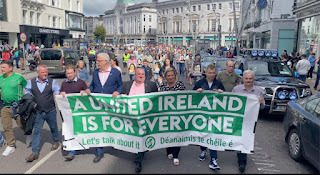
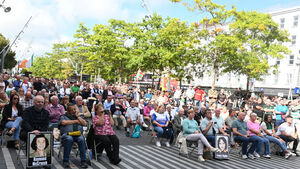 The Road To Cork.
The Road To Cork. In 1986 I gave a talk at a Sinn Féinconference which became known by activists of my vintage as The Road to Cork orThe Bus to Cork. More of that at another time. Suffice for now to say thatI made the journey to Cork a metaphor for thejourney to the new republic. I am minded of that now as our car speeds southand I sit in the back penning these words. The road to Cork is indeed a verylong road. So too the road to the new republic. But barring accidents we willget there.
I like Cork. It is a good walking city.Full of lovely hurlers and handsome heroes and heroines,melodic singers and wonderful writers. I love the sing song Cork accent. It isalso the homeplace of Terence MacSwiney. RG and I are going to Cork to attend the National Hunger Strike Commemoration onSunday. It’s the first time that this annual event will be held in Cork in honour of the ten 1981 hunger strikers and Michael Gaughan and FrankStagg who both died in English prisons and those Cork republicans - TerenceMacSwiney, Michael Fitzgerald, Joseph Murphy, Denis Barry and Andy O’Sullivan -who also died on hunger strike during the Tan War and the Civil War, and otherswho died on hunger strike in the intervening years.
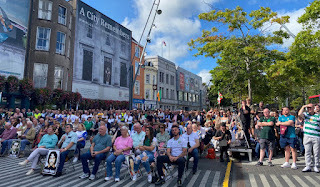 We got into Cork late on Saturday afternoonfor a session with Donnchadh Ó Laoghaire and mé féin about the hungerstrikesand books and writing and struggle and life.Go raibh maith agatDonnchadh. On Sunday morning Chris and I visited the Blarney Stone.Chris came away talking like RG. Then off to meet families of thehungerstrikers before making our way to join the walk from Kennedy Quay toGrand Parade and the National Monument.
We got into Cork late on Saturday afternoonfor a session with Donnchadh Ó Laoghaire and mé féin about the hungerstrikesand books and writing and struggle and life.Go raibh maith agatDonnchadh. On Sunday morning Chris and I visited the Blarney Stone.Chris came away talking like RG. Then off to meet families of thehungerstrikers before making our way to join the walk from Kennedy Quay toGrand Parade and the National Monument.
Thousands of us marched together and themizzley rain gave way to bright warm sunshine as we made our way through Cork citycentre for an inspiring session of speeches, poetry and songs.The main speakerMichelle O Neill told us; “We will achieve the sovereignty and independence ofour people….those twenty two who died on hungerstrike have left us ahuge legacy …. the Good Friday Agreement provides the means by which we canachieve unity. We need to prepare and plan and be ready for that….”
Bobby Sands and his comrades wouldagree.
Cork did the hungerstrikers proud. Welldone to all involved. Míle buiochas.
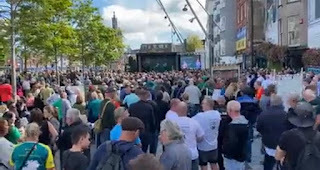
The Power Of X.
Before X there was Twitter.Apart from the ill mannered, ill informed and abusive, nasty andvulgar tirades that are the mark of some contributors I like these formsof communication.
I joined Twitter in January 2011on the direction of Shaun Tracy who was then one of our leading shadowy figuresin Leinster House. He continues to lead but in other shadowy sites of struggle.It is Shaun who is to blame for my twitterings over the years. He made themistake of letting me put up whatever came into my head. Once I evenpublished My Little Book Of Tweets. In part of course I was having the craic.But I was also countering the demonizing propaganda of the establishmentmedia, particularly the Dublin media. But that’s another story.
I recall one time getting areal sense of how useful and educational and democratic Twitter could be.Someone had put up a query about Luke Kelly’s rendition of PatrickKavanagh’s beautiful verse Raglan Road. I posted a video of Luke singing whatis undoubtedly the finest love song out. Best sung by him. Or me. Withinminutes someone else posted old black and white footage of Patrick Kavanaghhimself singing Raglan Road. The ability to bring these two wonderfullycreative people and the story of Kavanagh’s poem to a new audience was for me abrilliant demonstration of the power of Twitter.
Ditto, as Ted would say, with X.Last week I watched as BelfastStreetNames asked how McDonnell Street gotits name. McDonnell Street is in Belfast’s Falls area. Withinminutes @jjconeill@mastodon.ie told us that the streetwas named after a Francis McDonnell – a pawnbroker - who applied to The TownImprovement Committee to name the street after himself. John supplied a cuttingfrom the Northern Whig of 2 November 1866 to amplify his answer. He then wenton to tell us - complete with another appropriate Northern Whig cutting - how alarge number of weapons believed to belong to the Fenians was seized in one ofMcDonnell’s properties in Rosemary Street. According to the Northern Whig someof the weapons were new. Mr. McDonnell obviously escapedpunishment and went on to develop McDonnell Street. Presumably he proved thatsome needy Fenian pawned the weapons. Fascinating.
I remember Paddy Lavery’s PawnShop on the Falls Road. My mother sent me and our Margaret there regularly.Pawning stuff on a Monday to be redeemed on a Friday. But not a weapon amongthem.
Seamus Heaney.
August 30 marks the 10th anniversary of the death ofSeamus Heaney. I knew of Seamus before I knew him. He was a teacher in SaintThomas’ School on the Whiterock Road along with another fine scribe MichaelMcLaverty. Some of my brothers were pupils there. I know Seamus’s poetry sinceDeath of A Naturalist. His poems, and Patrick Kavanagh’s verses, have alwaysmoved me. My thoughts are with Seamus’s wife and family and with his friends atthis anniversary time.
BBC Radio 4 have a series on Seamus at 4.30 on Sundays - FourSides of Seamus Heaney. John Kelly’s Poet of Place is special. So is CatherineHeaney on her father’s poetry of love. RTE Radio’s John Bowman has also done aspecial slot on his Sunday morning archival programme for the lastfew weeks featuring interviews and readings by Seamus. All worth listeningto.
Bernadette O’Hagan from Lurgan died last week. She was astrong republican woman. An activist. She was 95. For 52 years she was marriedto Joe B who was himself a hugely respected activist. Joe B isespecially remembered for his part in the helicopter escape from Mountjoyprison in October 1973.
Bernadette was born in Lurgan just over six years afterpartition and the establishment of the Orange State. She was the youngest of 9children. From an early age Bernadette always had a grá mór for all thingsIrish – Music, dance, An Cumann Lúthchleas Gael,and the Irish language. Little wonder that this wee gael, this young activeIrish girl stuck in Lurgan in the apartheid core of the Orange State became anIrish republican.
In 1945 she met Joe B O’Haganshortly after his release from internment. They were married in 1949. Joe B was an activist in every decade from the 1940s until hisdeath in 2001. The family also have deep connections with Monaghan. In the late1960s Bernadette was a founding member of the civil rights campaignin Lurgan. Later in 1974 she was imprisoned in Armagh Gaol.
She was a strong advocate for the political prisoners,especially during the H Block/Armagh campaigns. Bernadette was active in theRelatives Action Committee. Two of her sons were on the blanket.
In May 1997 she was the Sinn Féin Upper Bann candidate in theWestminster election. The Sinn Féin vote increased across the North. In UpperBann Bernadette almost doubled our vote. Joe B and Bernadette supported thepeace process.
After Joe B’s death Bernadette continued herwork particularly with Naíscoil Cois Locha. Hundreds of pupilshave benefited from her vision and commitment and the efforts of othergaeilgeoirí in Lurgan, most especially around Bunscoil Naomh Proinsias.
Today Sinn Féin is the largest party in the Assembly and on thisisland. It’s a far cry from the days of Bernadette’s youth. We also have now ameans to end the union with England. This is in no small measure won to theactivism of comrades like Bernadette.
Bernadette was a woman of huge integrity, very genuine andsincere. Today we need more activism, more activists, not least so that we cansecure and win the referendum on unity which is part of the Good FridayAgreement. That is Bernadette’s generation’s gift to us. Let’s not waste it.Bernadette led by example. Let’s follow her example.
August 20, 2023
John Joe McGirl – an unbreakable Fenian: A master class on campaigning
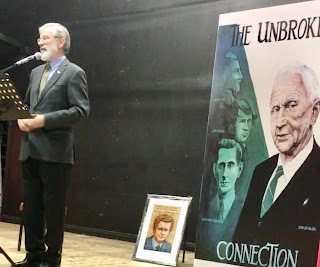 Speaking in Ballinamore to a packed hall on the legacy of John Joe McGirl
Speaking in Ballinamore to a packed hall on the legacy of John Joe McGirlJohn Joe McGirl – an unbreakable Fenian
In the course of almost 60 years of activism I havebeen very lucky to meet many wonderful, committed, compassionate republicans.On Saturday, in Ballinamore in County Leitrim, Republicans from Leitrim andbeyond will gather to celebrate the life of one of these – John Joe McGirl. Theannual John Joe McGirl commemoration is one of the highlights of theBallinamore Festival Week and the participants will walk from John McGahernSquare to the monument to John Joe opposite Amharclann an Oileáin (the Island Theatre).The monument was designed by Robert Ballagh.
Formany of my generation John Joe was an inspiration – a legend. I first methim in the late 1960s. I was in my late teens. I had travelled by bus fromBelfast to Enniskillen one Friday evening and then hitch-hiked to Ballinamore.I slept in a field in my trusty sleeping bag and I landed in Ballinamore on aSaturday morning.
JohnJoe brought me to Sliabh an Iarainn, to Lough Allen and to Drumshambo. The coalminers in Arigna were on strike and we attended one of their meetings. John Joewas deeply committed to transforming the lives of ordinary citizens burdened bypoverty and deprivation; and his concern for rural Ireland, and for the tens ofthousands forced to emigrate, helped to shape my own politics.
Heconnected the national and the local – a lesson I have never forgotten. Beforeanyone else he understood the importance of the restoration of our inlandwaterways. He was a champion of education and a great suppkrter of libraries.He was also a strong gaeilgeoir. And like me a faithful and hopeful supporterof our respective country teams.
I also met Bridie, John Joe’s wife. They hadmarried in 1951 and had five children Liam, Áine, Cait, Feargal and Nuala.Given the frequency of John Joe’s periods in prison Bridie did a great job ofrearing the children.
Aswell as being Vice President of Sinn Féin, a former POW and a TD and arepublican activist for decades, John Joe also had a long connection withBelfast. He had the distinction of being in two different prisons when bothwere set on fire by Republican POWs. The first time was in the notoriousCurragh in December 1940 where he was savagely beaten. The second time was LongKesh in 1974. John Joe had travelled to Belfast at Easter 1974 to give theEaster Commemoration speech. The Brits thought he was Seamus Twomey and he wasarrested. When they discovered their mistake John Joe was sent to the interneeend of the Long Kesh camp.
Whenhe arrived all us internees thought – poor oul John Joe – we all felt so sorryfor him. But there was no sadness or despair in John Joe. He had been down thisroad so many times before. Later in October that year the republican POWsburned Long Kesh to the ground. There was a fierce series of running battlesthrough the night and the following morning in different parts of the campbetween the Republican POWs and the British Army. In the midst of this John Joewas hit in the face by a rubber bullet. If my recollection is right his jaw wasfractured. As flames licked around the watch-towers I made my way to John Joeand asked how he was. His response – “I’m alright as long as you peopleare alright”.
Speakinglater about his time in Long Kesh John Joe said:“I spent nine months there…Isaw young men fight hand to hand with British soldiers. I know what it means tobe kicked, beaten, gassed, made to sleep in a blanket under a sheet of iron inthe month of October. I was glad to join this new generation in writing theirchapter in the fight for independence. I am proud to say of them – that nogeneration has produced braver or better”.
JohnJoe’s entire adult life was a reflection of the years of republican strugglethrough the 1930s, 40’s, 50’s, 60’s, 70’s and 80’s. Five decades of selflesscommitment to the struggle for Irish freedom and independence. He was the ‘unbreakableFenian’, the ‘gentle soldier’.
Duringthe 1981 hunger strike John Joe travelled the length and breadth of the staterallying support for the hunger strikers. In the June 1981 general electionCiaran Doherty and Paddy Agnew were elected as TDs. Joe McDonnell came close totaking a seat in Sligo Leitrim. Despite the risk of arrest John Joe attendedhis funeral in Belfast. He gave the oration at Joe’s graveside in Milltown. Hesaid: “Joe McDonnell died rather than debase the cause he served,rather than live with the forced tag of criminality on him… We will build JoeMcDonnell a memorial… that will be the freedom and the unity of the Irishpeople.”
In1986 John Joe seconded the motion calling for an end to the abstentionistpolicy towards Leinster House. As a former abstentionist TD it was a bigdecision for him to take. It was for him a necessary step if, in hiswords, “we are not going to hand down this struggle to anothergeneration”.
MartinMcGuinness like me loved John Joe. In a tribute to him Martin described JohnJoe as a “progressive thinker, always prepared to consider, support andpropose new ways for the Republican Movement to advance. He wasn’t prepared tostand still or hold to old outdated tactics which were incapable of developingthe struggle on all fronts… He was an extraordinary man, an inspiration toeveryone who knew him. We treasure his memory”.
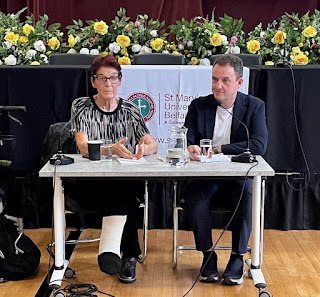
Ailbe Smyth with Colin Harvey
Amaster class on campaigning
Féilean Phobail was a resounding success and in particular it provided a wonderfulrange of debates and conversations on the many issues surroundingconstitutional change. Well done to Harry and Kevin, Sam and all the Féileteam. Maith sibh. The quality of the debates was excellent. All were packedout. The breadth of speakers – academics, journalists, political and communityactivists, sports people, - and the many shades of opinion, including a greaternumber than before of people from the broadly cultural Unionist/Protestanttradition, was uplifting.
Amongthese was a hugely informative conversation between human rights lawyer ColinHarvey and Ailbhe Smyth, a well known and highly respected campaigneron many social justice campaigns. Ailbhe was a key player in the successfulCoalition to Repeal the Eighth Amendment and was co-director ofTogether for Yes in 2018. She told of one of her first decisions to take astand in 1973. At that time she was a young academic in University CollegeDublin. When she got married in early 1973 UCD told her to leave. At that timethere was a bar on married women joining the civil service and if a womanmarried she had to resign. Ailbhe refused to leave. In June of that year newlegislation was introduced to lift the bar. Ailbhe stood her ground and won.
Colinand Ailbhe’s discussion centred on the role of Citizens’ Assemblies increating change and the risks and opportunities such Assemblies can present.Colin reminded us that there is a “huge political transformation taking place acrossthis island. And people across all sections of society are increasingly gettinginvolved in the conversation on our constitutional future.”
Itwas a master class from Ailbhe on how to run a campaign. The importance ofbeing inclusive, of strategising, the need to build alliances, the use oflanguage in messaging, the framing of the campaign and the managing and nutsand bolts of creating a cohesive multi-layered organisation.
August 10, 2023
Be an Activist; Rita O’Hare and Áras Uí Chonghaile: Internment and mass incarceration
Terry O'Sullivan, Paul Maskey and Jeremy Corbyn
BeAn Activist
I had theprivilege of attending many of the debates and discussions which are a uniqueand vital part of Féile an Phobail. Well done to all the participants and inparticular to the organisers and the stewards who ensured that everythingworked smoothly. Thanks also to the venues which welcomed us all.
I want totouch briefly on the remarks made by Terry O'Sullivan and Jeremy Corbyn atseparate events, particularly on the importance of organising civic society.Jeremy, a former leader of the British Labour Party and Terry the GeneralSecretary Emeritus of The Laborers' International Union of North America arewonderful advocates for the imperative of organising social and politicalmovements to bring about deep rooted and positive change.
For all ofthe differences in their two countries the need to organise people is a commonthread in their work. That and a fierce commitment to equality and socialjustice. And a love for Ireland. We are lucky to have them as allies andfriends.
Thiscolumnist is a long time believer in the power of people, properly organised,strategic and strong in their beliefs and values. There are lots ofcurrent and historic examples of the changes brought about by such movements inIreland and other parts of the world. Political change will be more meaningful,deep rooted and advanced if it is led by informed and committed citizens.Shaping a fair society is too important to be left solely to politicians. Ofcourse public representatives have an important role including the delivery of legislative and underpinned guarantees of peoplesrights once those rights have been won. But they are unlikely to be wonwithout popular struggle. Progress is dependent on that. Activism is central tothis. And activism works.
Jeremyquoted James Connolly to make this point. In an article “The Economic Basis ofPolitics”Connolly argued ‘an effective political force’ had to have itsorigins ‘deep down in the daily life of the people, not in the brains of somehalf dozen gentlemen in parliament.’
For hispart Terry O Sullivan told us that the ‘labour movement is once again on therise throughout North America ….a new generation of workers is beginning tounderstand the power of activism’
He outlinedhow LiUNA organised labourers, mostly emigrants with little rights orprotections. He like Jeremy spoke of the importance of solidarity. ‘Aninjustice to one is an injustice to all’. He said: ‘The trade unionmovement is the single most effective anti-poverty programme ever devised’.
Féile AnPhobail is a great example of activism and community empowerment. It isinclusive grassroots democracy in action. On all fronts. Cultural,educational and artistic. The creative arts for the many. And itsenjoyable. Full of hope and colour and vitality.
So activismworks. Creating a new Ireland means ending the union with England. There is nowa way to do this. Activism is crucial to secure that goal.
JamesConnolly believed in the reconquest of Ireland by the Irish people. I believein that too. So did Bobby Sands. Bobby wrote ‘The day will dawn when all thepeople Ireland will have the desire for Freedom to show. It is then we will see the rising of the moon.’
So there isspace for all progressives in the work to shape an empowered movement for a newshared Ireland. As Jeremy Corbyn said: ‘The planning, the preparation, and theconsultation needs to take place beforehand so that people know what the choiceis. What exactly is the proposition they are voting for. This requires seriousand novel engagement. Every available resource and expertise should be pooled.Citizens Assemblies, local forums and civic consultation should be utilised.That work will be done here in Ireland obviously.’
He went onto explain the role for people in Britain. Terry did the same in relation toNorth America. That is important. But few of us will have a contributionto make there. Our work is where we live.
And it is clear what we have to do here. Change is underway. Lets be activein shaping and deepening that change. Its time to get involved. Its timeto move beyond talking about it. Or leaving it to others. There is a rolefor everyone. Its time to be an active citizen. Its time forcampaigning, organising, for democratic empowerment. Lets do it. Be anactivist.
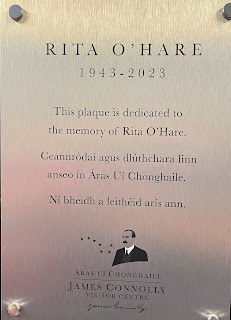 RitaO’Hare and Áras Uí Chonghaile
RitaO’Hare and Áras Uí Chonghaile
Áras UíChonghaile on the Falls Road was formally opened by Uachtarán na hÉireannMichael D Higgins in April 2019. Through its historic artefacts, art work,innovative technology and story-telling it teaches us of the life and times ofJames Connolly – 1916 executed leader.
LastThursday a large number of family, friends and comrades of Rita O’Hare cametogether to unveil a plaque in Áras Uí Chonghaile in her memory. Without herunique contribution this important project might never have succeeded.
WhenBelfast activists first discussed the possibility of opening a centre namedafter James Connolly they faced many difficulties. Finding the necessaryfunding was a particular challenge.
It was intothis critical gap that Rita O’Hare stepped. As Sinn Féin’s North Americarepresentative she was uniquely placed to help. Rita was quickly won over tothe merits of the project and with her contacts in the USA and especiallywithin the trade union movement she successfully reached out to nearly 20different unions seeking their solidarity and their funding. LiUNA inparticular, led by Terry O’Sullivan and the Transport Workers Union led by JohnSamuelson have been especially supportive.
As agrateful acknowledgement of Rita’s singular contribution and on the day Ilaunched a Léargas book celebrating Rita’s activism, Terry O’Sullivan formerLiUNA President and I unveiled the plaque to Rita. Well done Rita.
Also onsame day I launched a Léargas – An Bhean Dhearg: A Tribute to Rita O’Hare. Itis available from www.sinnfeinbookshop.com and An Fhuiseog 55 Falls Roadwww.thelarkstore.ie
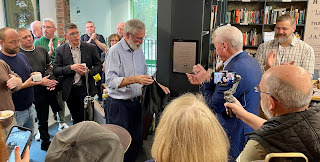
Internmentand mass incarceration
Wednesday 9August was the anniversary of one of the most disastrous decisions in recentIrish history. On the 9 August 1971 the Unionist Regime and British governmentintroduced internment without trial. It was a watershed moment in the historyof the northern state as hundreds were dragged from their homes, thousands offamilies were forced to flee to refugee camps, and many of those lifted in theearly morning raids were beaten.
Internmentwas an act of mass political violence and intimidation. It had been usedsuccessfully in every previous decade since partition by the Unionist Regime.On this occasion it failed.
The use ofinternment and detention centres also followed a pattern employed by Britishgovernments going back at least to the middle of the 19th century.
Followingthe failed insurrection in India in 1857 over 20,000 people were incarceratedin what were called ‘mass encampments.’ The conditions were appalling. Forcedlabour and starvation were deliberately used to coerce those detained. Suchcamps were not just used for political prisoners. Later in the 1870s and 1890swhen plague and famine struck in India new camps were established to separatethe hungry and sick. Forced labour of the weak and sick was used again.
During theBoer War the British government ordered the construction of around 100concentration camps into which more than 100,000 mainly women and children wereherded. They died in their thousands through malnutrition, starvation anddisease. In addition 30,000 prisoners of war were transported to remote partsof the British Empire.
After theEaster Rising 1500 men were interned without trial. Most were held in theFrongoch internment camp in Wales. In the 1950s and 60s such camps were againput to use in Malaya and Kenya and other parts of the British Empire as nativepeoples fought for independence. In her remarkable Pulitzer Prize winning book‘Imperial Reckoning,’ published in 2005 Caroline Elkins documented thesystematic torture and brutality that took place in Britain’s detention campsin Kenya. She revealed a British strategy of detention, beatings, starvation,torture, forced hard labour, rape, and castration, designed to break theresistance of the Kikuyu people. More than a million men, women, and childrenwere forced into barbed-wire village compounds and concentration camps.
Four yearslater in 2009 five survivors of the Kenya detention system successfully suedthe British government. The British have now changed the law here to preventhundreds who were illegally interned in the 1970s from suing them.
Frederick Douglass takes pride of place in Belfast; National Hunger Strike March for Cork: Gino and the Pen Behind The Wire.
Frederick Douglass takes pride of place in Belfast
A great crowd turned out on Monday morning inLombard St. in Belfast City Centre for the unveiling by Belfast City Ard MhearaRyan Murphy of a very fine statue of Frederick Douglass, escaped slave andhuman rights campaigner. It is a striking image of Douglass who is an iconicfigure for his work on campaigning for an end to slavery and for equality andjustice for African Americans and for women. He visited Ireland in 1845-46 justbefore the worst years of The Great Hunger.
He gave over fifty speeches during his time here.They are evidence of his great affection for Ireland and hisrecognition of the connection between the treatment of African Americans and ofmost Irish people in the 19thcentury under British rule. His wordsare a reminder of the evil andhorror that was and is slavery and of the work of the anti-slavery movementthat was active in Ireland during his visit.
Slavery had been opposed by radical Presbyterian’sin Belfast in the late 18th century. Efforts to form a slavecompany in the city were thwarted not least through the efforts of ThomasMcCabe, a United Irishman. Decades later a Ladies Anti-Slavery Society carriedon that good work. One of its founding members was Mary Anne McCracken, sisterof Henry Joy McCracken.
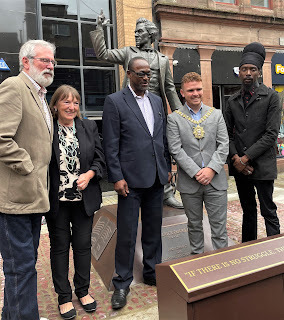 Douglass published his autobiography, ‘TheNarrative of the Life of Frederick Douglass, An American Slave’ in1845. The threat that pro-slaver elements would kidnap him and return hisas a slave to his former ‘owner’ was so great that he left the USA. Hearrived in Dublin where on 3 September 1845 he gave his first lecture. Over thefollowing months he travelled to Wexford, Waterford, Cork, Limerick andBelfast. He returned to Belfast another four times.
Douglass published his autobiography, ‘TheNarrative of the Life of Frederick Douglass, An American Slave’ in1845. The threat that pro-slaver elements would kidnap him and return hisas a slave to his former ‘owner’ was so great that he left the USA. Hearrived in Dublin where on 3 September 1845 he gave his first lecture. Over thefollowing months he travelled to Wexford, Waterford, Cork, Limerick andBelfast. He returned to Belfast another four times.
Ireland was in his own word “transformative.” Healso witnessed the awful conditions endured by Irish peasants and the impact ofAn Gorta Mór – the Great Hunger. Consequently, Douglass increasingly saw theissue of slavery not in isolation but as part of a wider campaign for equalityand social justice. He wrote: “I see much here to remind me of myformer condition, and I confess I should be ashamed to lift up my voice againstAmerican slavery, but that I know the cause of humanity is one the world over.”
At the unveiling of the statue there was a group ofyoung people from universities across the USA who are Frederick DouglassFellows. They have been in Ireland for a week learning about his time here.Also present were Professor Christine Kinealy and Don Mullan who have writtenextensively on Douglass and Takura Donald Makoni who is a policy officer withthe African Caribbean Support Organisation in Belfast.
Christine Kinealy is a historian, author and founding director of Ireland's Great HungerInstitute at Quinnipiac University inConnecticut. She has written extensively on Daniel O’Connell, the Great Hungerand, of course Frederick Douglass. In 2018 she published two authoritativevolumes on the life and times of Douglass and his visits to Ireland and toBelfast.
Douglass’s closeassociation with Belfast is a part of our history that needs to be told andretold. It is also a reminder that the evil of slavery and the desperate plightof refugees and asylum seekers are still with us. Slavery is not thepast. It is the present. Modern slavery may involve multiple forms ofexploitation, including human trafficking, child slavery, servitude, forcedmarriages and forced or compulsory labour. Many are women forced intoprostitution or domestic servitude. Women's Aid Belfast and Lisburn hasrecently reported that they are currently dealing with more than 230 femalevictims of human trafficking. In addition, there are millions across the worlddispossessed and fleeing war and hunger in their own places. Refugees andasylum seekers who deserve our solidarity and support.
So, the work of FrederickDouglass is not finished. Much progress has been made but the issues of racismand inequality and slavery continue to challenge society today. Last Christmasthe United Nations’ International Labour Organization (ILO) reported thatas many as fifty million people are trapped in slavery. These are men, womenand children who “cannot refuse or cannot leave because of threats, violence,deception, abuse of power or other forms of coercion.”
There is an obligation on all of us to speak out –just like Frederick Douglass, Thomas McCabe, Mary Ann McCracken and manyothers. Frederick Douglass’s statue in the heart of Belfast is a reminder ofthe proud history of this city in opposing slavery and of the work still to bedone.
Well done to Belfast City Council, to the sculptorAlan Beattie Herriot and his associate and fellow sculptor Hector Guest. Fàilte abhaile Frederick.
National Hunger Strike March for Cork
For the first time the annual National HungerStrike Commemoration will be held in Cork City on Sunday 27 August toremember the ten 1981 hunger strikers and Michael Gaughan and Frank Stagg.First Minister designate Michelle O’Neill will be the main speaker.
The Cork event will also remember those Corkrepublicans Terence MacSwiney, Michael Fitzgerald, Joseph Murphy, Denis Barryand Andy O’Sullivan who died on hunger strike during the Tan War and the CivilWar and all of those who died on hunger strike in the intervening years.
Those participating in theNational Hunger Strike Commemoration will assemble at 2pm at Kennedy Quay, CorkCity. It will proceed through the city centre to the National Monument at GrandParade. Bígí linn.
Gino and the Pen Behind The Wire.
Prisoners Day is an important date in the Féile anPhobail calendar. The event on August 11 in the Felon’s Club is an opportunityto look at exhibitions, hear talks on issues affecting former POWs, includingthis year an up-to-date on the CR Gas campaign.
A few weeks ago I noted the upcoming launch atPrisoners Day of a wonderful book of poetry, The Pen Behind The Wire, by Eoghan‘Gino’ MacCormaic. At the back of the book there is a list of family andfriends and comrades who recorded some of Gino’s poems with QR codes for readersto listen to the spoken word. Among the many contributors are his wife andother family members, Christy Moore, Lucilita Bhreatnach, Rosie McCorley, GerryKelly, mé féin and many more.
Gino follows in that centuries long tradition ofrepublican political prisoners who used their time in English prisons to writeabout their experience. Gino writes about the international experience also andlife beyond the walls of the H-Blocks where he spent 15 years – five of them onthe blanket.
There 76 poems in The Pen Behind The Wire. Welldone Gino.
Among them is ‘Easter 1982’. It is arecollection of the first Easter parade in the Blocks at which the namesof their fallen hunger strike comrades were read out.
Easter 1982
The Roll of Honour wasread, proudly,
And this year Ilistened, hearing for the first time
Bobby, Frank, andRaymond, Patsy, Joe,
Martin and Kevin,Kieran, Tom and Mickey.
I remembered then, inthat yard
In the quietness ofLong Kesh, Easter 1982
I remembered anotherEaster, two years before
When we stood, withthe Ten
Behind our lockeddoors.
Naked but for ourrobes, our blankets. On protest.
We thought, that day,that we would lose ten comrades
On hunger strike,demanding rights that now were greater
Than clothes? And twoyears on
Who could say thehunger strikers did not win?
Two minutes ofsilence. Parade! Dismiss!
And for a moment Iheard again the soft sound
Of five hundred barefeet stamping on the floor.
SInead O Connor.
My thoughts are with the family and friends ofSinead O Connor. Acres of words have been written about her since the sad,abrupt news of her death. But the most poignant are the stories of the manyquiet acts of kindness she was involved in.
A fierce warrior woman with a mighty voice and agood heart. Sinead was sound. An inspirational part of what we are. Gondeanfaidh Dia trocaire uirthi.
Gerry Adams's Blog
- Gerry Adams's profile
- 29 followers


